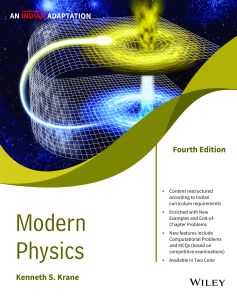Modern Physics, 4ed, An Indian Adaptation
ISBN: 9789354244681
644 pages
Publication Year: 2021
For more information write to us at: acadmktg@wiley.com

Description
This Indian Adaptation of the fourth edition of the book has been developed focusing on addition of new topics, and restructuring some of the existing concepts to make it a better-fit textbook for Indian Universities. The section on The Schrödinger Equation has been updated with more mathematical rigorous treatment. The section on Hydrogen Atom Wave Functions has been extended with detailed solutions of radial and angular parts of the Schrödinger equation through new solved Examples. The chapter on Solid State Physics now has extended discussion on Crystal Structures and Lattice Vibrations.
1. The Failures of Classical Physics
1.1 Review of Classical Physics
1.2 The Failure of Classical Concepts of Space and Time
1.3 The Failure of the Classical Theory of Particle Statistics
1.4 Theory, Experiment, Law
2. The Special Theory of Relativity
2.1 Classical Relativity
2.2 The Michelson–Morley Experiment
2.3 Einstein’s Postulates
2.4 Consequences of Einstein’s Postulates
2.5 The Lorentz Transformation
2.6 The Twin Paradox
2.7 Relativistic Dynamics
2.8 Conservation Laws in Relativistic Decays and Collisions
2.9 Experimental Tests of Special Relativity
3. The Particle-like Properties of Electromagnetic Radiation
3.1 Review of Electromagnetic Waves
3.2 The Photoelectric Effect
3.3 Thermal Radiation
3.4 The Compton Effect
3.5 Other Photon Processes
3.6 Particles or Waves
4. The Wavelike Properties of Particles
4.1 De Broglie’s Hypothesis
4.2 Experimental Evidence for de Broglie Waves
4.3 Uncertainty Relationships for Classical Waves
4.4 Heisenberg Uncertainty Relationships
4.5 Wave Packets
4.6 The Motion of a Wave Packet
4.7 Probability and Randomness
5. The Rutherford-Bohr Model of the Atom
5.1 Basic Properties of Atoms
5.2 Scattering Experiments and the Thomson Model
5.3 The Rutherford Nuclear Atom
5.4 Line Spectra
5.5 The Bohr Model
5.6 The Franck–Hertz Experiment
5.7 The Correspondence Principle
5.8 The Failure of the Bohr Model
6. The Schrödinger Equation
6.1 Behavior of a Wave a t a Boundary
6.2 Confining a Particle
6.3 The Schrödinger Equation
6.4 Applications of the Schrödinger Equation
6.5 Steps and Barriers
6.6 The Simple Harmonic Oscillator
7. The Hydrogen Atom in Wave Mechanics
7.1 A One-Dimensional Atom
7.2 Angular Momentum in the Hydrogen Atom
7.3 The Hydrogen Atom Wave Functions
7.4 Radial Probability Densities
7.5 Angular Probability Densities
7.6 Intrinsic Spin
7.7 Energy Levels and Spectroscopic Notation
7.8 The Zeeman Effect
7.9 Fine Structure
8. Many-Electron Atoms
8.1 The Pauli Exclusion Principle
8.2 Electronic States in Many-Electron Atoms
8.3 Outer Electrons: Screening and Optical Transitions
8.4 Properties of the Elements
8.5 Inner Electrons: Absorption Edges and X Rays
8.6 Addition of Angular Momenta
8.7 Lasers
9. Molecular Structure
9.1 The Hydrogen Molecule
9.2 Covalent Bonding in Molecules
9.3 Ionic Bonding
9.4 Molecular Vibrations
9.5 Molecular Rotations
9.6 Molecular Spectra
10. Statistical Physics
10.1 Statistical Analysis
10.2 Classical and Quantum Statistics
10.3 The Density of States 3
10.4 The Maxwell–Boltzmann Distribution
10.5 Quantum Statistics
10.6 Applications of Bose–Einstein Statistics
10.7 Applications of Fermi–Dirac Statistics
11. Solid-State Physics
11.1 Crystal Structures
11.2 Lattice Vibrations
11.3 The Heat Capacity of Solids
11.4 Electrons in Metals
11.5 Band Theory of Solids
11.6 Superconductivity
11.7 Intrinsic and Impurity Semiconductors
11.8 Semiconductor Devices
11.9 Magnetic Materials
12. Nuclear Structure and Radioactivity
12.1 Nuclear Constituents
12.2 Nuclear Sizes and Shapes
12.3 Nuclear Masses and Binding Energies
12.4 The Nuclear Force
12.5 Quantum States in Nuclei
12.6 Radioactive Decay
12.7 Alpha Decay
12.8 Beta Decay
12.9 Gamma Decay and Nuclear Excited States
12.10 Natural Radioactivity
13. Nuclear Reactions and Applications
13.1 Types of Nuclear Reactions
13.2 Radioisotope Production in Nuclear Reactions
13.3 Low-Energy Reaction Kinematics
13.4 Fission
13.5 Fusion
13.6 Nucleosynthesis
13.7 Applications of Nuclear Physics
14. Elementary Particles
14.1 The Four Basic Forces
14.2 The Particle Spectrum
14.3 Why High Energy?
14.4 Conservation Laws
14.5 Particle Interactions and Decays
14.6 Kinematics of Particle Decay
14.7 Kinematics of Scattering Processes
14.8 The Quark Structure of Mesons and Baryons
14.9 The Standard Model
15. Cosmology: The Origin and Fate of the Universe
15.1 The Expansion of the Universe
15.2 The Cosmic Microwave Background Radiation
15.3 Dark Matter
15.4 The General Theory of Relativity
15.5 Tests of General Relativity
15.6 Stellar Evolution and Black Holes
15.7 Cosmology and General Relativity
15.8 The Big Bang Cosmology
15.9 The Formation of Nuclei and Atoms
15.10 Experimental Cosmology
Questions
Problems
Appendix A: Constants and Conversion Factors
Appendix B: Complex Numbers
Appendix C: Spherical Polar and Cylindrical Coordinate Systems
Appendix D: Periodic Table of the Elements
Appendix E: Table of Atomic Masses
Appendix F: Some Milestones in the History of Modern Physics
Appendix G: Suggestions for Further Reading
Index

